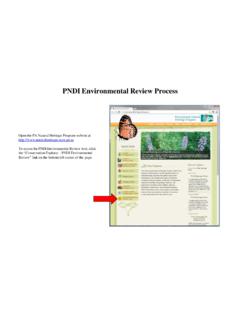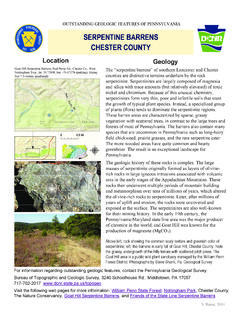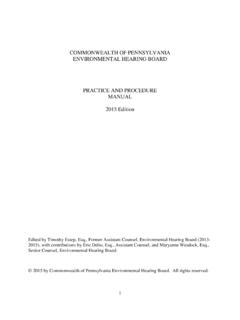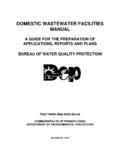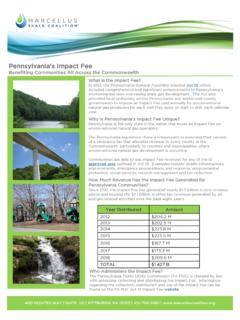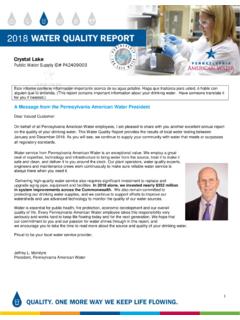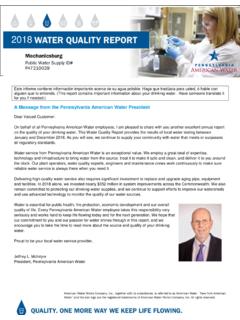Transcription of DEPARTMENT OF ENVIRONMENTAL PROTECTION
1 021-0200-001 / May 25, 2013/ Page i DEPARTMENT OF ENVIRONMENTAL PROTECTION Office of Field Operations DOCUMENT NUMBER: 021-0200-001 TITLE: Policy for pennsylvania Natural Diversity Inventory (PNDI) Coordination During Permit Review and Evaluation EFFECTIVE DATE: May 25, 2013 AUTHORITY: See Appendix E. POLICY: It is the policy of the DEPARTMENT of ENVIRONMENTAL PROTECTION (DEP) to fully support the PROTECTION of threatened and endangered species, and special concern species where applicable, during the administration of permit programs.
2 DEP will ensure that permit applicants utilize the pennsylvania Natural Heritage Program s (PNHP) pennsylvania Natural Diversity Inventory (PNDI) to achieve those ends. PNDI is the primary source of information utilized by DEP during the permit review process for the PROTECTION of threatened and endangered species, and special concern species where applicable. The PNDI coordination effort facilitates the avoidance and minimization of impacts to threatened and endangered species, and special concern species where applicable, in the Commonwealth of pennsylvania .
3 PNDI coordination has the benefit of supporting biodiversity conservation and sustainability, when implemented in a manner consistent with the requirements of the laws and regulations implemented by DEP. PURPOSE: The purpose of this policy is to guide permit applicants in meeting legal requirements related to the PROTECTION of threatened and endangered species, and as appropriate, special concern species. APPLICABILITY: This policy applies to applicable DEP permits and authorizations. It also applies to County Health Departments and County Conservation District permit review staff when conducting delegated duties on behalf of DEP.
4 The policy is not to be applied where it conflicts with statutory or regulatory requirements. DISCLAIMER: The policies and procedures outlined in this guidance are intended to supplement existing requirements. Nothing in the policies or procedures shall affect regulatory requirements. Nothing in this policy is intended to modify the provisions of existing agreements, or program-wide consultations and biological opinions. The policies and procedures herein are not an adjudication or a regulation. There is no intent on the part of DEP to give the rules in these policies that weight or deference.
5 This document establishes the framework within which DEP will exercise its administrative discretion in the future. DEP reserves the discretion to deviate from this policy statement if circumstances warrant. PAGE LENGTH: 22 pages (including appendices) 021-0200-001 / May 25, 2013/ Page ii TABLE OF CONTENTS 1. DEFINITIONS ..1 2. BACKGROUND ..2 The pennsylvania Natural Diversity Advantages of Early Rare and Significant Ecological Features ..2 3. POLICY AND PROCEDURES FOR PERMIT APPLICANTS ..3 A.
6 PNDI ENVIRONMENTAL Review Tool ..3 B. Project Area & Large Projects ..3 C. PNDI Search Form ..3 D. ENVIRONMENTAL Review Tool Questions ..4 E. PNDI Receipt ..4 F. Jurisdictional Agency Consultation ..5 G. Special Concern Species ..6 H. Options for Permit Applicants ..7 I. Exemptions and Emergencies ..8 J. Resolution of PNDI Screening Results ..8 APPENDIX A - DETERMINATION OF PROJECT TYPE AND AREA ..11 APPENDIX B - PNDI FORM ..12 APPENDIX C - PROCEDURES FOR SPECIAL CONCERN SPECIES ..14 APPENDIX D - JURISDICTIONAL AGENCY CONTACT LIST.
7 17 APPENDIX E - LISTING OF LEGAL AUTHORITIES ..19 021-0200-001 / May 25, 2013/ Page 1 1. DEFINITIONS: Critical Habitat: The specific areas within the geographic area occupied by a threatened or endangered species designated in accordance with the Endangered Species Act of 1973, 16 1531 et seq., that exhibit those physical and biological features essential to the conservation of the species and which may require special management considerations or protections. Impact: A negative effect on a plant or animal species, including destruction of species and loss of critical habitat.
8 Jurisdictional Agencies: pennsylvania DEPARTMENT of Conservation and Natural Resources (Bureaus of Forestry and Topographic and Geologic Survey), pennsylvania Fish and Boat Commission, pennsylvania Game Commission, and Fish and Wildlife Service. Permit: Authorizations issued by DEP, giving approval to perform a regulated activity. For the purpose of this policy, permits includes the authorization types such as: permits, plan approvals and registrations under general permits. This definition does not include certifications and licenses.
9 Permit Application: An application, notice of intent, request for plan approval, registration or other request for a permit. Permitted Activity: An activity requiring a permit under laws and regulations administered by DEP. Rare and Significant Ecological Features: Non-species resources identified on a PNDI Receipt. These may include unique geological features, significant natural features or significant natural communities. Special Concern Species: Plant and animal species that are not listed as threatened or endangered by a jurisdictional agency, but are identified on a PNDI Receipt as an at risk species.
10 These include: (1) plant and animal species that are classified as rare, vulnerable, tentatively undetermined or candidate, (2) taxa of conservation concern and (3) special concern plant populations. Threatened and Endangered Species: Those animal and plant species identified as a threatened or endangered species, as determined under: Endangered Species Act of 1973, 16 1531 et seq.; Wild Resources Conservation Act, 32 5301; Fish and Boat Code, 30 Pa. 101 et seq.; and Game and Wildlife Code, 34 Pa.
